
Kibbutz Be’eri: A piece of heaven on earth. That’s what Geoffrey Majzner says Kibbutz Be’eri was like just one year ago, before this idealistic place of peaceniks and pioneers became a massacre site. Before his sister was murdered in her home by Hamas terrorists as he sheltered in his bedroom just a few streets away. Galit Carbone: 66 years old. Mother of three, grandmother of six. The only Australian killed on the deadliest day in Israeli history.
Majzner - also known as Danny - describes his older sister as “exactly my opposite”. He is a boisterous bicycle-riding fanatic; she was a reserved librarian who loved watching British comedy shows. Yet they circled each other through their lives. Their Jewish parents moved the family from Sydney to Israel when the siblings were aged seven and 11, settling in Kibbutz Be’eri. They both moved to Perth, married, divorced and returned to live in the kibbutz. They couldn’t stay away. Nothing compared to life in Be’eri, located just four kilometres from the border with Gaza.
“There were no hassles, no pollution, no police, kids running around in the street,” Majzner says as he guides us through the kibbutz wearing a black “I love Be’eri” T-shirt. The kibbutz was founded in 1946 by utopian, left-wing Zionists who believed in communal living and direct democracy. Today Be’eri stands out among Israel’s 270-odd kibbutz communities (known as kibbutzim) for being especially well-off: home not just to thriving crop plantations but one of the nation’s biggest printing presses.
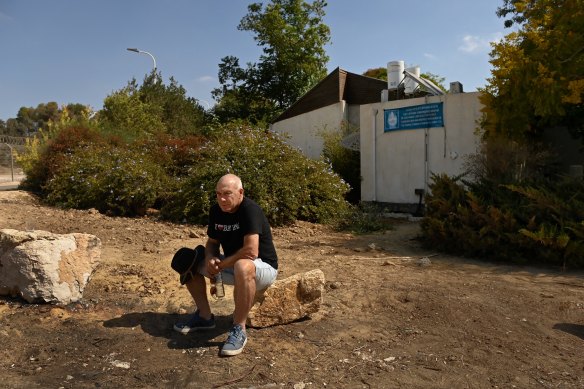
Australian Israeli Geoffrey “Danny” Majzner sits in front of the house of his sister, Galit Carbone, who was killed by Hamas during the October 7 attack on Kibbutz Be’eri.Credit: Kate Geraghty
Asked what his sister loved most about life here, he says: security. Despite occasional rocket fire from Gaza, she felt protected in her home and delighted in hosting visits from her relatives.
That sense of safety was shattered when around 200 Hamas terrorists stormed across the border and entered the kibbutz brandishing machine guns and hand grenades. Majzner was heading out for an early morning bike ride when their air raid sirens sounded just after 6.30am. He would spend the next 20 hours holed up in his apartment, using his phone to communicate with neighbours and relatives as he waited for help to arrive. His sister stopped responding soon after the attack began; she was likely one of the first people to die that day given her home was at the entrance of the kibbutz near the border fence.
When Majzner emerged he found a scene of carnage. Dead bodies of Hamas terrorists strewn on the street, his neighbours’ homes torched and ransacked. A total of 101 civilians died at the kibbutz that day, about one in 10 residents. A further 30 were taken hostage into Gaza.
Loading
“The main question we ask, and all of Israel asks all of the time is: where was the army?” Majzner says. “From anywhere in Israel, two hours is enough time to get the army there. Where were they? We feel betrayed.” It’s a question that eludes a satisfactory answer a year later.
The kibbutzim played a crucial role in the creation of the state of Israel, helping to establish a Jewish foothold in the Negev desert and make the dry earth bloom. On that day the state failed these communities catastrophically.
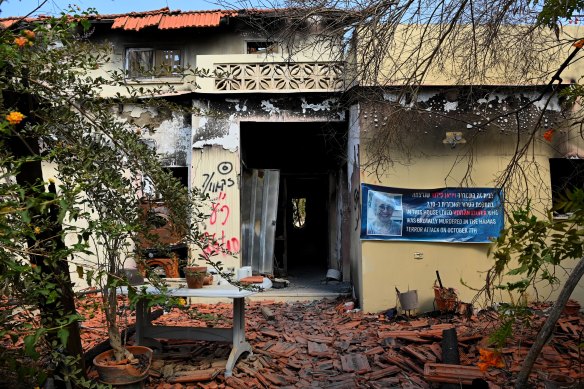
The home of Canadian peace activist Vivian Silver who was murdered by Hamas during the October 7 attack in Kibbutz Be’eri.Credit: Kate Geraghty
A year later, the green grass has returned to the kibbutz. So have about 80 residents who live in undamaged houses and do not have children. Most of Be’eri’s 1000 residents, however, have not returned to their homes. Many remain in hotel resorts near the Dead Sea while they wait for the construction of temporary housing in a nearby kibbutz. About 110 of the homes at Be’eri are being demolished while others stand frozen in time – pocked with bullet holes and grenade dents. Majzner plans to spend most of his time living in Tel Aviv before returning in three years when the rebuilding effort is advanced. A week after the attacks, he had a Be’eri October 7 tattoo inked onto his calf, a physical representation of how much the place means to him.
Visit Be’eri today and you will hear not just the birdsong of more tranquil times but the regular thud of Israeli artillery being fired into Gaza. It’s a visceral reminder that the war triggered by the October 7 attacks grinds on a year later, at a tremendous cost to Palestinian lives, even as the world’s attention shifts to Israel’s northern border with Lebanon. Almost 42,000 Palestinians have died in the war, according to the Gazan health ministry.
Walking through the kibbutz’s mostly empty streets, we pass the home of Vivian Silver, a Canadian-Israeli peace activist who helped sick Palestinians from Gaza travel to Israel for cancer treatment and other essential medical care. She was killed on October 7 in her home.
“They didn’t care who she f---ing was,” Majzner says angrily. “They burnt her alive in this place.”
Before the attacks, the kibbutzniks were among Israel’s most progressive and pro-peace residents. While some hold firm to those beliefs, others find their hearts hardening after the attacks.
“I moved from left-of-centre to right-of-centre for sure,” Majzner says. “How can we say we want to live in peace with our neighbours when they want us dead, when they want us out of here? If you ask me now there’s no co-existence in my opinion.”
He says he is “pissed off” with Foreign Minister Penny Wong’s decision not to visit a kibbutz during her January visit to Israel and the Australian government’s broader approach to the region (Wong used a speech to the United Nations last week to call for a deadline for the creation of a Palestinian state). But he’s no fan of Israeli Prime Minister Benjamin Netanyahu, who leads the most right-wing government in Israeli history. Majzner believes Netanyahu has scuttled a second hostage release deal to ensure he remains in power. So do many of his fellow kibbutzniks, as seen by the posters plastered around Be’eri blaming Netanyahu for the fact 120 hostages remain in Gaza.
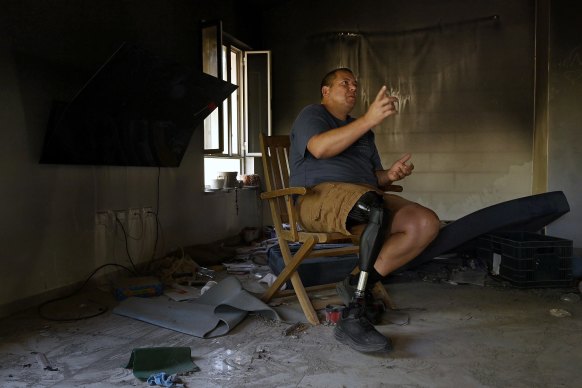
Avida Bahar was shot in the leg by Hamas militants on October 7, 2023. The wound was so serious his leg had to be amputated. Credit: Kate Geraghty
As our tour continues, Majzner introduces us to one of his best kibbutz cycling buddies: Avida Bahar. As the kibbutz’s head of agriculture, he is responsible for overseeing its jojoba, avocado, pomelo and wheat crops. Sitting among the debris of that day still scattered around his burnt-out house – glue sticks, clothes, toys – he tells his story. On October 7, he was at home with his wife Dana, 15-year-old son Carmel and 13-year-old daughter Hagar. When they realised the kibbutz was under attack they fled to their safe room and pressed their bodies against the door. Unable to enter the room, the terrorists shot through the door – hitting Bahar in the legs and his son in the arm. They then threw grenades packed with screws and nails into the safe room, sending shrapnel flying.
Dana, who was beloved in the community for her work taking care of local children, died after a bullet pierced her side. “I told my daughter, ‘Hagar, your Mum isn’t suffering any more,’ ” Bahar recalls. “We have to keep Carmel alive. This is our mission.”
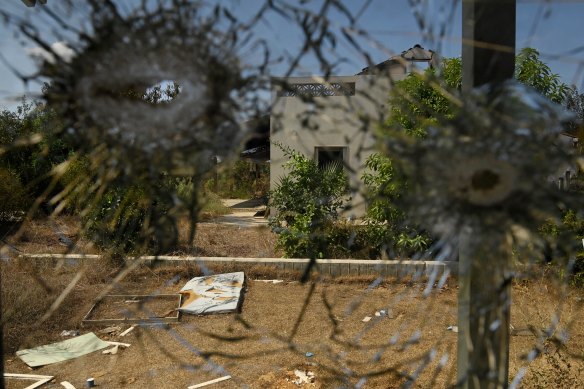
View from Avida Bahar’s safe room in his home in Kibbutz Be’eri.Credit: Kate Geraghty
Yet 15 minutes later, Carmel’s breathing shortened and he died. He was a passionate surfer who had been planning a surfing trip to Sri Lanka.
“Carmel told me, ‘Dad when you bury me, bury me with my surfboard.’ He only thought about surfing,” Bahar says.
Bahar and Hagar were eventually rescued by the Israeli military, but Bahar’s right leg wound was so serious his leg had to be amputated. He spent over six months in hospital and now walks with the help of a prosthetic limb. His advice, based on so much loss and pain, is to never miss a second with those you love: “Never say tomorrow. With your family, your friends, never say tomorrow.”
His political advice is more provocative. Bahar says that before October 7, he happily employed Palestinians from Gaza in his crop fields and supported a peace settlement with Israel’s Palestinian neighbours. He now believes Gazans must be driven away from the Israeli border and into another Arab-majority country like Lebanon or Egypt.
“I hope Be’eri is going to rebuild again with no safe rooms, no fence and our border being the Mediterranean Sea,” he says. “In the Holocaust we didn’t have land. Now we have land and we have to protect it.”
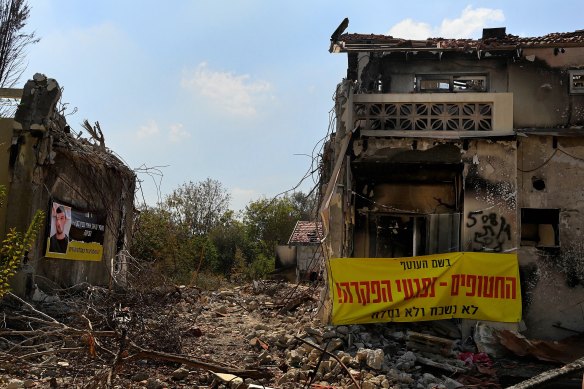
An image of Itay Svirsky on a banner (left) with the words, “Bring Itay Svirsky’s body. We don’t give up till everyone comes back”. Another banner (right) states, “The hostages hurt because they were abandoned! We won’t forget and we won’t forgive”, on destroyed homes in Kibbutz Be’eri.Credit: Kate Geraghty
Many will shudder at his call for the mass displacement of Palestinians from Gaza, but it reflects the rage many Israelis continue to feel a year after the attacks. According to an October Gallup poll, just 27 per cent of Israelis support a two-state solution, down from 61 per cent in 2012. Rebuilding a kibbutz is one thing; rebuilding any sense of trust with those who live across the border is a more difficult task entirely.
Get a note directly from our foreign correspondents on what’s making headlines around the world. Sign up for the weekly What in the World newsletter here.



























